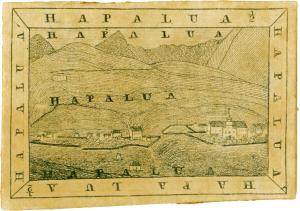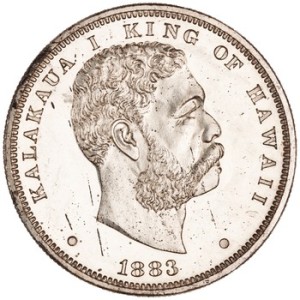
In October 1874, a New Zealand traveler bound for San Francisco stopped over in Honolulu, taking lodging at the idyllic Royal Hawaiian Hotel. The gentleman’s pleasing stay was, however, soon disrupted when he tendered a sovereign to settle the bill for a sumptuous breakfast. To his “utter amazement,” he received the following in change: “one English sixpence, two American dimes, two ditto half dimes, one quarter-dollar, a silver coin of Napoleon III, a Peruvian dollar, and a Mexican coin of some value indistinguishable.” Dashing the money back in anger, he demanded “some one currency or other” that “represented something definite,” but it was coolly returned by the proprietor with assurances that it was “all current coin of the realm.” With nothing to do except pocket the “museum,” as he took to calling his new collection of coins, the bewildered gentleman went for a stroll while considering the extraordinary monetary system that prevailed in the Hawaiian Islands. While United States coins had become the predominant currency by the 1870s, a motley mix of English, Austrian, French, Italian, Russian, Belgian, Mexican, Peruvian, and Spanish coins also had legal tender status at fixed rates set by the minister of finance. Moreover, a table published in an 1875 Hawaiian almanac shows an even greater range of coinage in circulation. This combination of currency turned everyday transactions into complicated affairs that could often overwhelm unfortunate visitors like our touring New Zealander.

The diversity of coinage present was a reflection of the prominent role that the Hawaiian Islands played during the nineteenth century as the crossroads of an emerging Pacific world shaped by the integrative forces of colonialism and capitalism. What follows is a short numismatic history of the islands during this transformative century, one that begins with the introduction of Western money during the late eighteenth century and ends with annexation of Hawai‘i by the United States in 1898. !is period was defined by the rise and fall of the Hawaiian Kingdom and the shifting cultural, commercial, and international relationships in which it was enmeshed. A numismatic perspective offers an illuminating, if admittedly idiosyncratic, way of looking at how Hawaiian history unfolded over the course of the nineteenth century. Coins and currency played a varying role in the islands, at once undermining the traditional basis of Native Hawaiian society while also buttressing the fortunes of the Kingdom in its struggle to remain independent. !e apogee of this story was the national coinage issued by King Kalākaua in 1883, which was meant to bring order to the chaotic currency situation and to reaffirm Hawaiian sovereignty. The removal of the Kalākaua coins from circulation a few years after the annexation of the islands in 1898 was thus a richly symbolic move by the United States as it consolidated control over the new colony…read more.
